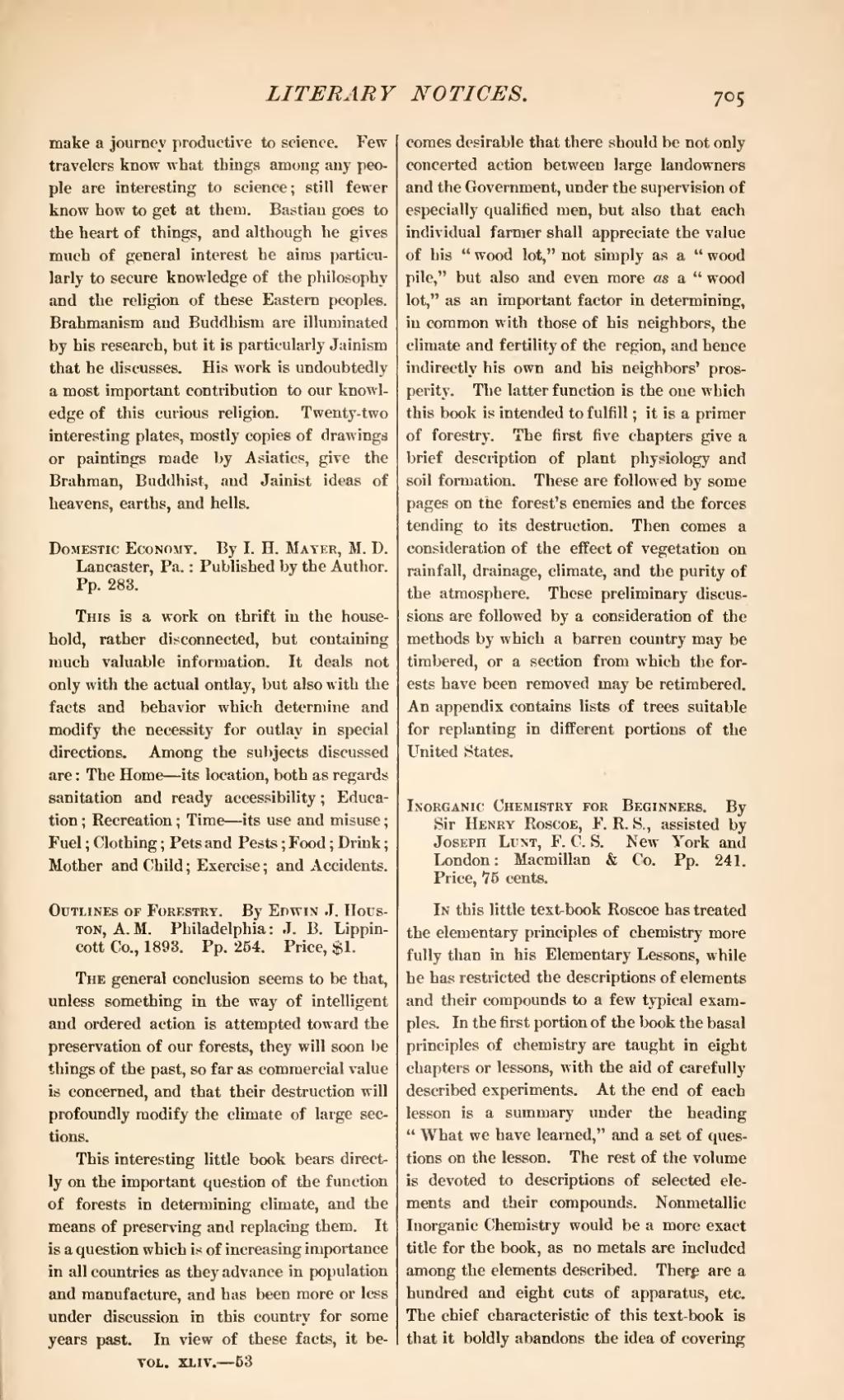make a journey productive to science. Few travelers know what things among any people are interesting to science; still fewer know how to get at them. Bastian goes to the heart of things, and although he gives much of general interest he aims particularly to secure knowledge of the philosophy and the religion of these Eastern peoples. Brahmanism and Buddhism are illuminated by his research, but it is particularly Jainism that he discusses. His work is undoubtedly a most important contribution to our knowledge of this curious religion. Twenty-two interesting plates, mostly copies of drawings or paintings made by Asiatics, give the Brahman, Buddhist, and Jainist ideas of heavens, earths, and hells.
Domestic Economy. By I. H. Mayer, M. D. Lancaster, Pa.: Published by the Author. Pp. 283.
This is a work on thrift in the household, rather disconnected, but containing much valuable information. It deals not only with the actual outlay, but also with the facts and behavior which determine and modify the necessity for outlay in special directions. Among the subjects discussed are: The Home—its location, both as regards sanitation and ready accessibility; Education; Recreation; Time its use and misuse; Fuel; Clothing; Pets and Pests; Food; Drink; Mother and Child; Exercise; and Accidents.
Outlines of Forestry. By Edwin J. Houston, A. M. Philadelphia: J. B. Lippincott Co., 1893. Pp. 254. Price, $1.
The general conclusion seems to be that, unless something in the way of intelligent and ordered action is attempted toward the preservation of our forests, they will soon be things of the past, so far as commercial value is concerned, and that their destruction will profoundly modify the climate of large sections.
This interesting little book bears directly on the important question of the function of forests in determining climate, and the means of preserving and replacing them. It is a question which is of increasing importance in all countries as they advance in population and manufacture, and has been more or less under discussion in this country for some years past. In view of these facts, it becomes desirable that there should be not only concerted action between large landowners and the Government, under the supervision of especially qualified men, but also that each individual farmer shall appreciate the value of his "wood lot," not simply as a "wood pile," but also and even more as a "wood lot," as an important factor in determining, in common with those of his neighbors, the climate and fertility of the region, and hence indirectly his own and his neighbors' prosperity. The latter function is the one which this book is intended to fulfill; it is a primer of forestry. The first five chapters give a brief description of plant physiology and soil formation. These are followed by some pages on the forest's enemies and the forces tending to its destruction. Then comes a consideration of the effect of vegetation on rainfall, drainage, climate, and the purity of the atmosphere. These preliminary discussions are followed by a consideration of the methods by which a barren country may be timbered, or a section from which the forests have been removed may be retimbered. An appendix contains lists of trees suitable for replanting in different portions of the United States.
Inorganic Chemistry for Beginners. By Sir Henry Roscoe, F. R. S., assisted by Joseph Lunt, F. C. S. New York and London: Macmillan & Co. Pp. 241 Price, 75 cents.
In this little text-book Roscoe has treated the elementary principles of chemistry more fully than in his Elementary Lessons, while he has restricted the descriptions of elements and their compounds to a few typical examples. In the first portion of the book the basal principles of chemistry are taught in eight chapters or lessons, with the aid of carefully described experiments. At the end of each lesson is a summary under the heading "What we have learned," and a set of questions on the lesson. The rest of the volume is devoted to descriptions of selected elements and their compounds. Nonmetallic Inorganic Chemistry would be a more exact title for the book, as no metals are included among the elements described. There are a hundred and eight cuts of apparatus, etc. The chief characteristic of this text-book is that it boldly abandons the idea of covering
